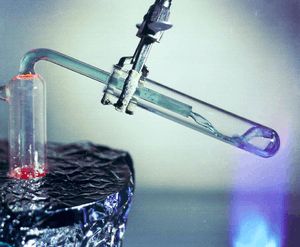Molten salt
Molten salt is salt which is solid at standard temperature and pressure but enters the liquid phase due to elevated temperature. A salt that is normally liquid even at standard temperature and pressure is usually called a room temperature ionic liquid, although technically molten salts are a class of ionic liquids.

Uses
Molten salts have a variety of uses. Molten chloride salt mixtures are commonly used as baths for various alloy heat treatments, such as annealing and martempering of steel. Cyanide and chloride salt mixtures are used for surface modification of alloys such as carburizing and nitrocarburizing of steel. Cryolite (a fluoride salt) is used as a solvent for aluminium oxide in the production of aluminium in the Hall-Héroult process. Fluoride, chloride, and hydroxide salts can be used as solvents in pyroprocessing of nuclear fuel. Molten salts (fluoride, chloride, and nitrate) can also be used as heat transfer fluids as well as for thermal storage. This thermal storage is commonly used in molten salt power plants.[1]
A commonly used thermal salt is the eutectic mixture of 60% sodium nitrate and 40% potassium nitrate, which can be used as liquid between 260-550 °C. It has a heat of fusion of 161 J/g,[2] and a heat capacity of 1.53 J/(g K).[3]
Experimental salts using lithium may have a melting point of 116 °C while still having a heat capacity of 1.54 J/(g K).[3] Salts may cost $1,000 per ton, and a typical plant may use 30,000 tons of salt.[4]
Regular table salt has a melting point of 800 °C and a heat of fusion of 520 J/g.[5][6]
Ambient temperature molten salts
Ambient temperature molten salts (also known as ionic liquids) are present in the liquid phase at standard conditions for temperature and pressure. Examples of such salts include N-ethylpyridinium bromide and aluminium chloride mix, discovered in 1951[7] and ethylammonium nitrate discovered by Paul Walden. Other ionic liquids take advantage of asymmetrical quaternary ammonium cations like alkylated imidazolium ions, and large, branched anions like the bistriflimide ion.
See also
- Electromagnetic pump
- Molten salt battery
- Molten salt reactor
- Parabolic trough
- Molten salt oxidation
- United States Department of Energy International Energy Storage Database
- Ionic liquid
References
- "Molten Salts systems other applications link to Solar Power Plants" (PDF). National Renewable Energy Laboratory (NREL). Archived from the original (PDF) on 2011-10-19. Retrieved 2011-09-06.
- "Molten salts properties"
- Reddy, Ramana G. "Novel Molten Salts Thermal Energy Storage for Concentrating Solar Power Generation" page 9 University of Alabama College of Engineering. Retrieved 9 December 2014.
- Bullis, Kevin. "Cheap Solar Power at Night" MIT Technology Review, 12 March 2012. Retrieved 9 December 2014.
- "NaCl CID 5234, 4.2.14 Other Experimental Properties"
- "NaCl Other Chemical/Physical Properties"
- Hurley, F. H.; Wier, T. P. J. Electrochem. Soc. 1951, 98, 203.
External links
- Journal of Chemical Thermodynamics
- Proc. Roy. Soc.
Bibliography
C.F. Baes, The chemistry and thermodynamics of molten salt reactor fuels, Proc. AIME Nuclear Fuel Reprocessing Symposium, Ames, Iowa, USA, 1969 (August 25)